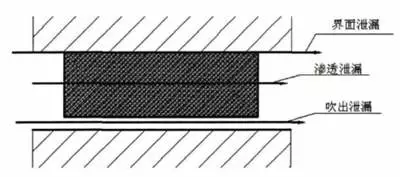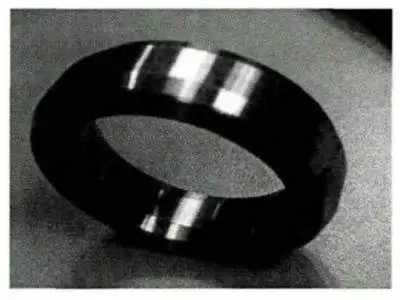Types and Failure Modes of Gaskets
Posted: 04/16/2022 10:09:48 Hits: 90
Generally, there are three main leakages for fluids at the sealing port, including leakages at the interface, leakages caused by penetration, and leakages caused by a blow-out, as shown in Figure 1.
The leakage at the interface is the leakage along the gap between the gasket and flange. This leakage is the main form of leakage, accounting for 80% to 90% of the total leakage. Leakages caused by penetration refer to the leakage through the capillary of the gasket material, which is mainly related to the structure and material properties of the gasket, accounting for 10% to 20% of the total leakage. There are two different kinds of leakages caused by blow-out. One is that when the total load of the clamping gasket is reduced to almost equal to the hydrostatic pressure acting on the end of the joint due to various reasons, and the sealing surfaces will tend to separate, resulting in a large amount of leakage; the other is that the sealing surfaces remain in contact. The pressing load reduces. When fluid pressure is great, the fluid pressure acting along the radial direction of the gasket will tear the deteriorated material with poor mechanical integrity, causing massive leakages of sealed fluids.

Figure 1 Leakages of gaskets
There are various types of gaskets, which can be divided into metal, non-metallic and semi-metallic gaskets according to the used materials. Metal-to-metal contact gaskets mainly include flat gaskets, O rings and octagonal gaskets. Sealing by octagonal gaskets is a forced seal, which consists of upper and lower flanges and octagonal gaskets installed in the groove surfaces of the upper and lower flanges. Under the action of forced force, the side of the groove is in contact with the inclined surface of the octagonal gasket to achieve sealing. The inclination angle of the inclined plane of the gasket is 23°, and the material used is metal, which makes the gasket have features of simple structure, small sealing force, a certain self-tightening effect in the radial direction, good sealing performance, and is suitable for high temperatures, high pressure, and harsh conditions that non-metallic gaskets and metal-clad gaskets cannot handle. For the sealing of chemical equipment and pipelines, its structure is shown in Figure 2.

Figure 2 The structure of octagonal gaskets
Common failures for gaskets include excessive gasket stress, insufficient compression and rebound, and deterioration or corrosion of gasket materials, excessive extension or extrusion of gaskets, crushed gaskets, and incorrect dimensions. The sealing surface of the flange is uneven; the sealing surface is damaged, and the contamination or corrosion of the sealing surface is also the cause of the failure. When the above failures occur, the causes should be analyzed according to the specific circumstances, and reasonable corrective measures should be taken.
The leakage at the interface is the leakage along the gap between the gasket and flange. This leakage is the main form of leakage, accounting for 80% to 90% of the total leakage. Leakages caused by penetration refer to the leakage through the capillary of the gasket material, which is mainly related to the structure and material properties of the gasket, accounting for 10% to 20% of the total leakage. There are two different kinds of leakages caused by blow-out. One is that when the total load of the clamping gasket is reduced to almost equal to the hydrostatic pressure acting on the end of the joint due to various reasons, and the sealing surfaces will tend to separate, resulting in a large amount of leakage; the other is that the sealing surfaces remain in contact. The pressing load reduces. When fluid pressure is great, the fluid pressure acting along the radial direction of the gasket will tear the deteriorated material with poor mechanical integrity, causing massive leakages of sealed fluids.

Figure 1 Leakages of gaskets
There are various types of gaskets, which can be divided into metal, non-metallic and semi-metallic gaskets according to the used materials. Metal-to-metal contact gaskets mainly include flat gaskets, O rings and octagonal gaskets. Sealing by octagonal gaskets is a forced seal, which consists of upper and lower flanges and octagonal gaskets installed in the groove surfaces of the upper and lower flanges. Under the action of forced force, the side of the groove is in contact with the inclined surface of the octagonal gasket to achieve sealing. The inclination angle of the inclined plane of the gasket is 23°, and the material used is metal, which makes the gasket have features of simple structure, small sealing force, a certain self-tightening effect in the radial direction, good sealing performance, and is suitable for high temperatures, high pressure, and harsh conditions that non-metallic gaskets and metal-clad gaskets cannot handle. For the sealing of chemical equipment and pipelines, its structure is shown in Figure 2.

Figure 2 The structure of octagonal gaskets
Common failures for gaskets include excessive gasket stress, insufficient compression and rebound, and deterioration or corrosion of gasket materials, excessive extension or extrusion of gaskets, crushed gaskets, and incorrect dimensions. The sealing surface of the flange is uneven; the sealing surface is damaged, and the contamination or corrosion of the sealing surface is also the cause of the failure. When the above failures occur, the causes should be analyzed according to the specific circumstances, and reasonable corrective measures should be taken.
Post URL: https://www.landeepipefitting.com/types-and-failure-modes-of-gaskets.html
Landee is a professional industrial pipe fitting manufacturer and be well accepted by customers all over the world, we has been producing Pipe Fitting for a variety of applications since 1985. welcome to access our website: https://www.landeepipefitting.com.
Previous: The Failure Analysis of the Stainless Steel TP304 Tee (Part Two)
Next: Materials of Pipe Fittings for Resisting Hydrogen Sulfide Stress Corrosion
Next: Materials of Pipe Fittings for Resisting Hydrogen Sulfide Stress Corrosion
